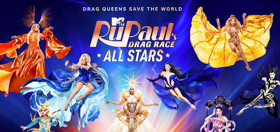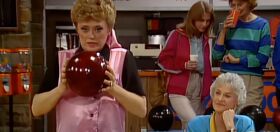
Perhaps you’ve just started using she/they pronouns or you have a friend who has. Or perhaps you’ve just heard about she/they pronouns and you want to learn more about how to use them. Whatever your reason, you’ve come to the right place – especially if you’re looking for a flag that represents this particular set of pronouns.
Here, we break down everything you need to know about she/they pronouns and the accompanying flag.
RELATED: Why some people use she/they & he/they pronouns
What Are She/They Pronouns?
She/they pronouns are “rolling pronouns” or multiple pronouns that can be used alternately or shift over time. While anyone can adopt rolling pronouns, they are most typically used by transgender and non-binary folks who want to affirm their connection to womanhood or femininity. This is particularly true for non-binary or transgender people who identify as lesbian or assigned female at birth (AFAB) and non-binary people who identify as bisexual or pansexual.
How about we take this to the next level?
Our newsletter is like a refreshing cocktail (or mocktail) of LGBTQ+ entertainment and pop culture, served up with a side of eye-candy.
Writer and podcast host Ada Powers describes it best: “I identify as a woman, but also as nonbinary. I don’t feel womanhood tells my full story, but I’m not fully divested from it, either.”
Breaking Down Some Terms
If this all sounds a bit confusing, let’s take a few steps back to explain some terms.
Non-Binary
Non-binary is a term used to describe people who don’t strictly identify as either male or female.
For most people, gender is black or white or, in other words, binary. But for non-binary individuals, gender is more like a spectrum or a range where they can identify somewhere between male and female or even outside of the spectrum altogether. Some non-binary people identify as having more than one gender identity – this is called bigender or polygender.
Non-binary is both a gender identity and an umbrella term for other gender identities that don’t follow the gender binary. Other gender identities that may use she/they pronouns include genderfluid, bigender, and demigirl.
Genderfluid
Genderfluid people have a gender identity that is in a constant state of flux. This means that they may identify as more male one day, more female on another, and agender or genderless the next.
Genderfluidity doesn’t necessarily happen day by day. Genderfluid people may have long periods wherein they feel more male/female/neither.
Bigender
Bigender people identify as having two genders at the same time.
Demigender
Demigender people identify partially with one gender. Some people use bigender and demigender interchangeably, but they’re not exactly the same thing. Whereas bigender people tend to feel like they have a combination of two different genders, demigender people often feel like they can identify with only one gender – just to a lesser degree.
Demigender people can identify as demigirls, demiboys, demienby, or demifluid.
How To Use She/They Pronouns
It can be confusing to use rolling pronouns at first, especially because different people have different preferences for how they’re used. Some people prefer to rotate or alternate their pronouns within a single sentence or from sentence to sentence. Others may have a preferred pronoun set depending on the day – this is especially common for genderfluid people whose gender identity fluctuates.
So, how do you get them right? As a rule of thumb, always ask someone what their pronouns are and how they want them to be used. Ask if they have a preferred pronoun or if you can alternate between the two. If you ask politely, most people will gladly explain their pronouns – and they’ll especially appreciate the time and effort you took to get their pronouns right.
?-??she/they lesbian flag!
?: for lesbians who use she/they pronouns, exclusively or not 🙂
?-??i hope you like it, anon! pic.twitter.com/tMbLVwkrbv— kore's flags ? reqs closed! (@korelationflags) June 2, 2022





















Chrisk
“Perhaps you’ve just started using she/they pronouns or you have a friend who has.”
Nope and nope. I try to keep my distance from people like that.
Chrisk
Ha. That reminds me of the movie Pat. He/she was ahead of their time.
kish
What the fck are your talking about.
It’s difficult to respect other people? You seem like a nightmare.
mastik8
She/they pronouns flag? Nope. Just No. There’s a road to hell paved with these things.
GlobeTrotter
“Some people prefer to rotate or alternate their pronouns within a single sentence or from sentence to sentence. Others may have a preferred pronoun set depending on the day – this is especially common for genderfluid people whose gender identity fluctuates.”
Thanks, but no thanks. Each person is entitled to his/her own delusion. I, however, don’t have to share in it.
Polaro
I had this happen too. It changes its pronouns all the time. No.
GlobeTrotter
@kish: You don’t “respect” other people’s delusions.
kish
That’s an @sshole comment, from a presumed @asshole.
GlobeTrotter
@kish: “That’s an @sshole comment, from a presumed @asshole.”
The desperate reflexes of a vapid mind.
FYI, delusions are treated, not “respected”.
skeldare
Wait, since when do pronouns require a flag?
kish
you’re repeating yourself and calling others vapid. It wasn’t insightful the first time.
kish
Queerty has, in the past, not allowed me to post articles from reputable publications about trans identity, but will allow old, narrow-minded f@ggots to post inflammatory comments about nonbinary people being “pudgy” or “attention seeking.”
Who the fck monitors this website?
inbama
So the self-appointed pronoun police-person is going to insult gay men for being old and use a slur yet?
Who do you think actually won those rights so that narcissistic babies like you could spend their lives inventing countless genders and demand that people bow to their pronouns?
The LGBT movement used to be about equality. The idea that everyone must buy into the latest version of queer theory and act accordingly or be labeled a bigot or driven out has nothing to do with human or civil rights. That is what CULTS do.
mastik8
Agreed. Who monitors this website. You just posted inflammatory comments about people who you believe posted inflammatory comments and they let you do it. What next? Are we now to be exposed to contrary opinions? Does this precedent now allow people to express themselves freely? If we are not careful we’ll be allowed to agree to disagree soon. Then what?
monty clift
@kish, Nobody cares about your pronouns or imaginary problems. How about you go f*ck yourself with a pudge stick and f*ck off this website, toots.
Polaro
No one monitors this site at this time, best I can tell. They once had some looney leftist do it, and she was horrible. What I find completely true about non-binary people is that it is all about fashion. They have no real skin in the game, mostly being straight and wanting some attention at our expense.
bachy
YMMV, but I find it best to just be myself, accept my body, and avoid requiring others to fragment the language to accommodate natural, hourly shifts in masculine or feminine feelings, perceptions and expression.
GlobeTrotter
@kish: No, I was referring to just you.
inbama
@kish
You’re the one who started name-calling because someone expressed a different opinion, and you dare to talk about respect?
You’re just a hypocrite behaving like a child. Grow up.
Diplomat
Kish,
Eviscerating the English language. Men exposing themselves in women’s locker rooms. Men forcing themselves on women sports teams. Boys and girls bathroom reversal. Grade-schoolers being punished for using wrong pronouns. And we’re saying no. I think you need to take a look at where the disrespect started and where it stands. There’s no disrespect in putting up boundaries around an out-of-control scenario by saying no. Non-binary xand trans need to go back to the drawing board and quit offending American people with their psychotic ideologies and actions. We almost had Coeur d’Alene Pride destroyed by 31 militants. Pride parades are cancelling around the country due to death threats. And look who’s tilting the balance board. Trans and non binaries. There will come a day not far off for the gay LGB community, that e will realize it’s incredible mistake of allowing trans and non-binary Etc onto the moniker of LGB. We are now at the brink of major loss of life for the entire Spectrum of LGB sexual orientation due to these actions. We don’t mind your trans or nonbinary but we do mind your irrational actions that bring us harm. There is no thinking through your actions and we as the LGB community are paying for it. As are parents of children and children in school wrestling with all these issues you’ve laid B4 us.
Trans should push for their own locker rooms and stay off women’s sports teams. And also drop the fictitious use of calling a single person they. It’s irrational and the country as a whole hates it. Save lives. Reorient your presentation to the world, before another person dies.
Ari
Every time we add a new flag, acronym… or a new term like “latinx”, we lose a congressional seat. Please stop with this stuff and these articles.
Polaro
Bingo. The republicans love it. Also, every time we have a drag queen read to children we lose a seat.
Diplomat
So correct. Drag queen hour reading to kiddies? Please. Do resist draggies! Another dent in the LGB community. It all adds up to arsnic based PR. Not a good look.
bachy
Some have begun to call Transgenderism the Q-anon of the Left.
andrewl
This pronoun debate highlights the confusion of these poor souls that have such gender issues. My God I would hate to identify as bi-gender how complex one’s outlook on life must be. So while I sympathise with their personal struggles I am not getting drawn into their turmoil by this craziness.
monty clift
I really don’t care what these idiots what to call themselves but they have NO business forcing their pronoun nonsense into LGBT
monty clift
Pronoun elitism. People like this have no real problems in life that’s why they can fixate their time on nonsensical beliefs.
iminheatlikeacat
Oh dear. Readership doesn’t seem to like this one. Will you listen, or do a “she/they” and continue to sledgehammer the issue in the hope you will grind us down (instead, making us dig our heels in the trenches further?)
Lol, I jest! Of course I know there’ll be no listening.
tallskin4
iminheatlikeacat -you say: “I know there’ll be no listening.”
Listening to what?
Most of us are atheists and don’t believe in religious cults
UlfRaynor
tallskin4– How dare you insult the self righteous indignation of the Sisterhood of Perpetual Hormone Replacement and the divine order of the majestic church of the Holy Nonbinary.
RiBrad
This article would not be out of place on a satirical comedy site.
My favourite bit is where it says if you ask politely, “most” people will gladly explain their daily pronouns to you. Are we meant to mind read which pronoun they want that day? And be shamed if we guess the wrong one or don’t roll it between sentences appropriately?
Narcissistic nonsense.
Jim
Self centred narcissist use they/them pronouns.
Get over yourselves
Polaro
Theyselves, sweetie, don’t be mean. :-0
Polaro
@Kish, honey, you live in a bubble. We’ve probably lost reproductive choice. We may lose the right to marry. All because of people like you who are so arrogant you don’t care about the damage to LGBT people because of this noxious Q+IA nonsense. You and your ilk are dangerous to us.
Polaro
It is untenable in a business. I refuse to waste my hard won political capital I’ve earned over the years with management representing for LGBT rights on pronouns. I will not do it. My biggest fear is more governments pass laws to require non-binary pronouns and I fear the political backlash will end us. You really think forcing people at work to use these stupid pronouns won’t backfire more than gay marriage, you are smoking strong dope.
Diplomat
There have been two cases that I know of where teachers have rebelled against using psycho pronouns, have gone to court and won via the 1st amendment and religious rights. However a Virginia school just made it punishable if you do not conform to these irrational pronoun requests/demands, punishing children as young as 4th grade. Probably the next court case.
I think it’s important for LGB people to take a firm opposing stand on this so as not to strain us with this lunacy, thereby protecting ourselves from attack.
Right now we are their front runners for this slanderous activity unless we speak up, loud and clear. I think it’s best served by dropping the T and whatever non binary reference used (Q?) from our acronym. It’s just gone too far to sit around and watch this lunacy destroy the LGB community.
Polaro
@Diplomat I am all for dropping the QIA from our team – they are toxic nuts. While no one asked me when they appended trans onto our team, and I was not happy about it when it happened, I am sympathetic to their plight. Trans people do not deviate from the male/female gender reality. They do not use made up pronouns. While I refuse to accept that a trans woman is a woman, I believe trans people exist, and I do not have a problem with accepting them as people. Where I find the trans movement to be a real harm to us all, including themselves, is when people insist that there is no difference between trans people and non-trans; e.g. trans women in women’s sports. So, no I would not throw out the trans people from the coalition, even with this problem, but I would insist that we all respect women’s spaces and stop demanding people agree that trans women are women; they aren’t.
The republicans will use all of this to shore up their power. 2022 will be ugly for us. I’m numb. Stupidly, the looney left handed it to them on a silver plater. I had hoped to live until a time when being a gay man wasn’t a risky position; and I survived the 80’s and AIDS. Based on this nutty social engineering from far-left nuts, many of whom are straight, I now doubt it.
Polaro
Your irony is fun.
HenryCameron
How did we get from I’m gay, I was born this way, and I just want the right to marry my partner and be treated equally, to I’m a gender-queer demi-something, morphing and melding from second to second, and my pronouns, which you must use, are they, xim, no, she, shim, no, he, they, no….? These people need counseling, not indulgence.
tallskin4
OH DEAR, HOW PATHETIC1
Ooo, the Queerty censor is back at work deleting unwoke comments
Errant
Well, this is depressing. There’s just as much intolerance here as at far right sites. Gotta say, I’m surprised and disheartened af.
IvanPH
These woke queers can’t even define what a male is or a female is yet they call themselves non-binary, bigender, etc.
This idiocy is taking gay rights 50 years back.
maxlovesrio
When someone starts this crap with me, I tell them I’m racially and age fluid and today I am white and 40, but I think I’ll be black and 21 tomorrow.
I am not going to be bothered to try to remember someone’s pronouns de jour. If they get offended, they can get over it. It’s not someone’s drama I would want in my life.
maxlovesrio
Also, just enjoy life. Why all the drama? These people remind me of a guy I know who got curse word face tattoos and then complained that he couldn’t find a job. Why make life harder than it has to be!